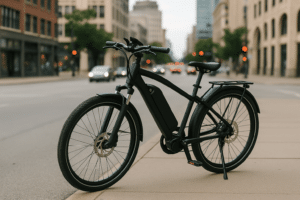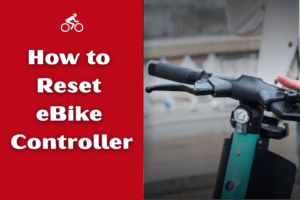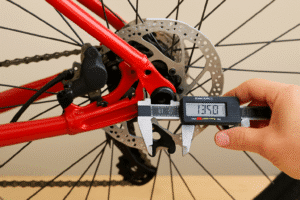Yes, you can do a wheelie on an eBike, and for many riders, it can actually be easier than on a regular bike thanks to the motor assist.
In this article, we’ll walk you through everything you need to know about doing wheelies on electric bikes.
You’ll learn how it compares to regular bikes, what challenges to expect, which types of eBikes work best, how to prepare safely, and the key techniques to help you get it right.
Whether you’re a beginner or just curious, this guide will help you get started the right way.
What is a Wheelie and How Does it Work?

A wheelie is a maneuver where the front wheel of a bicycle lifts off the ground while the rider balances on the rear wheel. The key to a successful wheelie lies in finding and maintaining the balance point, typically around 45 degrees, where the bike is slightly past or below this angle.
This balance is achieved by a combination of pedaling and braking, requiring the rider to constantly adjust to maintain this delicate equilibrium.
On an eBike, this balance point can be easier to reach and maintain due to the bike’s motor assistance.
Can You Do a Wheelie on an eBike?
Yes, you can definitely do a wheelie on an eBike. In fact, eBikes can make learning and performing wheelies easier compared to regular bikes. Their motor assistance helps in lifting the front wheel and maintaining the wheelie for longer periods, especially at higher speeds.
Why Choose an eBike for Wheelies?
Opting for an eBike to perform wheelies brings a unique blend of technology and skill to this classic biking maneuver. Here’s why an eBike could be your go-to choice for mastering wheelies:
- Ease of Lifting Front Wheel: The motor assistance in electric bikes makes it easier to lift the front wheel with just a couple of pedal kicks.
- Longer Duration: eBikes help maintain wheelies for extended periods and at higher speeds.
- Uphill Advantage: Riding wheelies uphill can be easier on electric bikes due to the additional power and gravity’s assistance.
- Learning Environment: Practicing in grassy areas with eBikes can be safer, and using flat pedals with sneakers offers better control.
Read more: Best e-bikes for wheelies
eBike Vs Regular Bike: Which One Is Better for Wheelies?
In my opinion, eBikes have a slight edge over regular bikes when it comes to performing wheelies. The motor assistance in electric bikes provides a significant advantage, especially for beginners. It helps in easily lifting the front wheel and maintaining the wheelie, which can be more challenging on a regular bike.
However, the weight of eBikes can make them harder to handle in case of a fall or when needing to jump off. Regular bikes, being lighter, offer more control in such situations. Ultimately, the choice depends on the rider’s preference and skill level.
What Are the Challenges of Wheelieing on an eBike?

While eBikes offer advantages for wheelies, they also come with their own set of challenges.
Weight of the Bike
The added weight of electric bikes, due to their motor and battery components, is a significant factor to consider. This increased mass can affect the bike’s handling during a wheelie, especially in scenarios where quick maneuvers are required.
If you flip over or need to jump off in an emergency, the heavier bike can be more cumbersome to manage, increasing the risk of injury or damage to the bike.
Motor Response
Each eBike has its unique motor response characteristics. Some models offer a smooth and gradual power delivery, which can aid in achieving a more controlled and stable wheelie. On the other hand, eBikes with abrupt power delivery can make it challenging to find and maintain the balance point, as the sudden bursts of speed can disrupt your equilibrium.
Familiarizing yourself with how your eBike responds to pedal input is essential for mastering wheelies on it.
Safety Concerns
The inherent power of electric bikes, capable of quick acceleration, introduces a significant safety concern. This is particularly true when attempting wheelies, as the increased speed can lead to loss of control.
It’s crucial to always wear appropriate safety gear, including a helmet, gloves, and protective padding. Practicing in a controlled and safe environment, away from traffic and obstacles, is also vital for reducing risk.
Skill Level Requirement
While eBikes can make it easier to start a wheelie, mastering the maneuver on a high-powered electric bike demands a higher level of skill and control.
Beginners should start with lower power settings and progressively work their way up as they gain confidence and improve their technique. This gradual approach helps in building the necessary skills safely and effectively.
Equipment Adjustments
To optimize an electric bike for wheelies, certain adjustments or upgrades might be necessary. This could include changing the handlebars for better grip and control, upgrading the wheels for improved balance, or tweaking the brakes for finer modulation.
Additionally, for eBikes with regenerative braking systems, adjusting the regen levels can impact how the bike handles during a wheelie, particularly in terms of braking and balance control.
These adjustments should be tailored to the specific model and the rider’s personal preferences to enhance the wheelie experience.
How to Prepare for Wheelieing on an eBike?
Before attempting a wheelie on an eBike, it’s crucial to prepare adequately to ensure safety and increase the chances of success.
- Safety Gear: Always start with the right safety gear. A helmet, gloves, and protective padding are essential.
- Brake Check: Ensure your brakes are in top condition, particularly the rear brake, which is vital for controlling the wheelie.
- Practice Area: Choose a safe practice area, preferably with grass to cushion any falls. Avoid crowded places.
- Bike Settings: Familiarize yourself with your eBike’s settings. Start with lower power settings and gradually increase as you gain confidence.
- Flat Pedals and Sneakers: Use flat pedals and wear sneakers for better control and easier bail-outs.
- Mental Preparation: Stay positive and patient. Learning to wheelie takes time and practice.
Can You Wheelie on Different Types of eBikes?
Yes, you can perform wheelies on various types of eBikes, but the experience may differ based on the bike’s design and motor placement. Mid-drive motor eBikes often offer a more balanced feel, making it easier to find the wheelie’s balance point.
However, eBikes with motors in the rear or front hub can also be used for wheelies. The key is understanding how your specific eBike responds to pedal input and adjusting your technique accordingly.
Each eBike model has its unique characteristics, so it’s important to spend time getting to know your bike.
What Are the Risks and How to Mitigate Them?
Performing wheelies on an eBike comes with its risks, primarily due to the bike’s power and weight. The main risks include losing control due to rapid acceleration or failing to handle the bike’s weight during a fall.
To mitigate these risks, start with lower power settings, ensure your safety gear is on, and practice in a safe, controlled environment.
Gradually build up your skill level and don’t rush the learning process. It’s also crucial to ensure your bike is in good condition, with special attention to the brakes and tires.
What Are the Key Techniques for Successful eBike Wheelies?
To successfully pull off an ebike wheelie, you’ll need to master a few key techniques that help with balance and control. The most crucial aspect is finding and maintaining the balance point, which is typically around 45 degrees. This balance is achieved by a combination of pedaling and braking.
When you start, lean back slightly, akin to a sloth, to lift the bike into the balance point. Keep your gaze forward, focusing on the horizon, as this helps maintain balance and prevents the bike from dropping.
Continuous pedaling after the wheelie pops is vital to keep control and balance. Remember, practice makes perfect, and it’s all about finding that sweet spot where your bike feels almost weightless.
For a comprehensive guide on mastering wheelies on an electric bike, check out this insightful video by Jeremy from Berkshire Bike and Board. Jeremy expertly breaks down the process, covering everything from finding the balance point to pro tips for maintaining control.
Conclusion
Doing e bike wheelies can be a thrilling experience, but it takes preparation, patience, and regular practice to get it right. Start with the right safety gear and a suitable practice area.
Understand the key techniques, such as finding the balance point and maintaining it through pedaling and braking.
Remember that different eBikes will offer different wheelie experiences, so get to know your bike well.
Always be aware of the risks involved and take steps to mitigate them. With time and practice, you’ll be able to enjoy the thrill of wheelieing on your eBike safely and confidently.
FAQs
Can you do jumps on an e-bike?
Yes, you can do jumps on an e-bike, especially if it’s a model designed for off-road or trail riding. Just make sure your suspension, frame, and wheels are built to handle the impact.
Can you do tricks on an e-bike?
You can definitely do tricks on an e-bike, but it depends on the bike’s weight and design. Lighter models with responsive handling are better suited for tricks like wheelies, manuals, or small hops.
Does wheelie damage the e-bike?
If done properly and occasionally, wheelies won’t damage your e-bike. But repeated hard landings or poor control can stress the frame, motor mount, or rear wheel over time.
Can you wheelie a 1000W e-bike?
Yes, a 1000W e-bike has more than enough power to do a wheelie. In fact, the extra torque can make it easier to lift the front wheel, but it also means you need to be careful with throttle or pedal input to stay in control.To successfully perform a wheelie on an eBike, mastering a few key techniques is essential.
Al Amin Morshed is the founder of BoltBikers and a seasoned e-bike reviewer with years of hands-on experience testing electric bikes. As a long-time e-bike enthusiast, he combines real-world riding insights with in-depth research to create honest, helpful content for riders of all levels. Through BoltBikers, Morshed aims to make e-biking more accessible, practical, and enjoyable – whether you’re a new rider or a daily commuter looking for the best gear.








